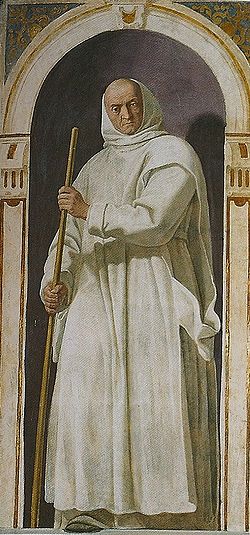- Odo of Novara
-
Blessed Odo of Novara 
Odo of Novara, by Daniele Crespi (1629), Garegnano Charterhouse in Milan.Born c. 1105
Novara, ItalyDied 1200
Tagliacozzo, ItalyHonored in Roman Catholic Church Beatified 1859 Feast 14 January Odo of Novara (c. 1105–1200) was an Italian Carthusian monk.
A native of Novara, he was appointed as prior of Geirach in Slovenia. However, he experienced difficulties with Dietrich, the local bishop, who persecuted him. Odo went to Rome to request the pope to relieve him of his office.[1]
After resigning as prior, he became a chaplain for many decades at the monastery at Tagliacozzo.
Veneration
After his death, an inquiry into his manner of life was ordered by Gregory IX.[2] He was described at the inquiry by Richard, bishop of Trivento, as a "God-fearing man, modest and chaste, given up day and night to watching and prayer, clad only in rough garments of wool, living in a tiny cell… obeying always the sound of the bell when it called him to office."[3]
His feast day in the Roman Martyrology is January 14.
References
- ^ Alban Butler, Paul Burns, Butler's Lives of the Saints (Continuum International Publishing Group, 2000), 96.
- ^ Alban Butler, Paul Burns, Butler's Lives of the Saints (Continuum International Publishing Group, 2000), 96.
- ^ Alban Butler, Paul Burns, Butler's Lives of the Saints (Continuum International Publishing Group, 2000), 96.
External links
Categories:- 1105 births
- 1200 deaths
- Carthusians
- Beatified people
- 13th-century venerated Christians
- People from the Province of Novara
Wikimedia Foundation. 2010.
